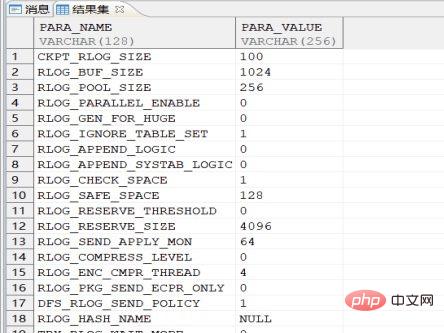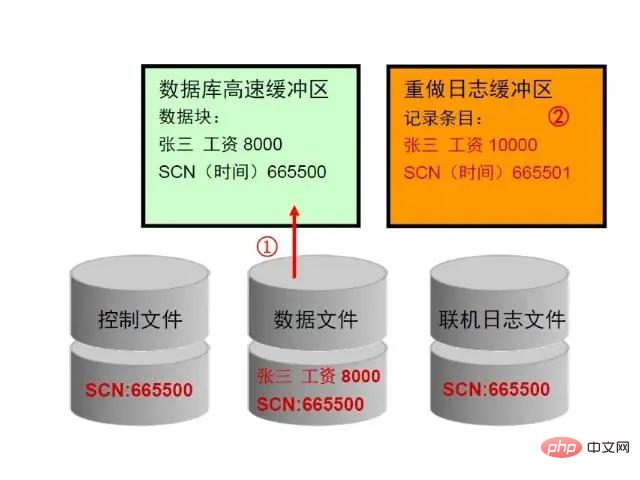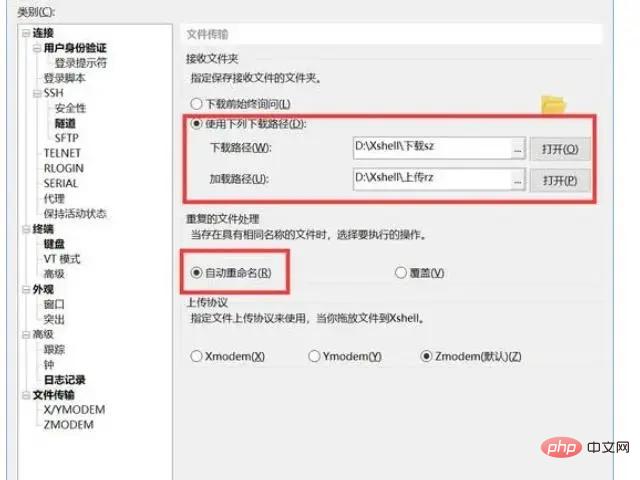Logger buffer size what is log used for
The function is to provide feedback usage information and records to engineers to facilitate problem analysis (used during development); since users themselves do not often generate upload logs, they are useless to users. The logging buffer is a small, temporary area used for short-term storage of change vectors for redo logs to be written to disk. A log buffer write to disk is a batch of change vectors from multiple transactions. Even so, the change vector in the log buffer is written to disk in near real-time, and when the session issues a COMMIT statement, the log buffer write operation is performed in real time.

The operating environment of this tutorial: Windows 7 system, Dell G3 computer.
The function of log recorder buffer size log is: mainly used to feedback usage information and record to engineers to facilitate problem analysis (used during development); since users themselves do not often generate upload logs, so for User is useless.
The logging buffer is a small, temporary area used for short-term storage of change vectors for redo logs that will be written to disk. "Change vectors" are modifications applied to certain objects. Executing a DML statement will generate a change vector applied to the data.
With redo logs, the database can ensure that data is never lost: whenever a data block changes, the change vector applied to the block is written to the redo log. If the data file needs to be restored, then Redo logs allow change vectors to be extracted and applied to data file backups.

The session server process does not write redo records directly to the redo log file, otherwise the session will have to wait for a disk I/O operation whenever a DML statement is executed Finish. Instead, the session writes redo records to an in-memory log buffer. This will be much faster than writing to disk. Thereafter, the log buffer (which may contain alternating change vectors for multiple sessions) is written out to the redo log file. Therefore, a log buffer write to disk is a batch of change vectors from multiple transactions. Even so, the change vector in the log buffer is written to disk in near real-time, and when the session issues a COMMIT statement, the log buffer write operation is performed in real time. Writing operations are done by the log writer background process (LGWR).

Features
The log buffer is smaller compared to other memory structures because it is a very short-lived storage area . Insert the change vector into it and have it flow to disk in near real-time. The log buffer does not need to be larger than a few MB at most, and indeed, setting it larger than the default can have a very bad impact on performance. The default value is determined by the Oracle server and depends on the number of CPUs in the server node.
In the developer options, there is an option called "Logger Buffer Size". The default is 256K. Logs are written to the buffer in a circular manner. Under normal circumstances, the oldest one is full. The log will be deleted to make room for new logs.
The size of the logger buffer is generally adjusted according to the individual. It can be set smaller to clean up faster. If you don’t care much, you can set it slightly larger, like around 100.
Theoretically, within a certain value, the bigger the better (because it determines the number of application layers you can open).
Since users themselves do not often generate upload logs, there is no need to adjust it to the minimum. Users can use the default settings. For example, in the case of high device configuration, the default value or even the maximum value can be increased to meet the user's personalized needs.

How to set
The log buffer cannot be set smaller than the default value. If you try to do this, the log buffer will be set to the default size. It is possible to create a buffer larger than the default, but this is generally not recommended. The problem is that when a COMMIT statement is issued, part of the commit processing involves writing the log buffer contents to the redo log file on disk. The write operation is performed in real time, and while it is in progress, the session that issued the COMMIT will be suspended. Commit processing is a key part of Oracle's architecture. To ensure that a committed transaction is never lost, the data block in the cache cannot be changed until the data block has been changed (meaning that the transaction has completed) and the change vector has been written to the redo log on disk (so that the transaction can be restored if necessary). Returns a commit completion message to the session. A large log buffer means that when a COMMIT statement is issued, more content needs to be written, and it takes longer before the completion of the commit message is issued and the session resumes work.

illustrate:
For some applications it is necessary to set the log buffer size higher than the default, but generally use the default log buffer to start tuning.
The log buffer is allocated when the instance is started and cannot be subsequently resized without restarting the instance. It is a circular buffer. The current write address moves back and forth as the server process writes change vectors to it. The log writer process writes out vectors in batches, at which point the space it occupies becomes available and can be covered by more change vectors. At times of peak activity, change vectors may be generated faster than the log writer process can write them out. If this happens, all DML activity will stop for a few milliseconds while the log writer clears the buffer.
In Oracle architecture, dumping the log buffer to disk is one of the basic bottlenecks. DML cannot be faster than LGWR can dump change vectors to online redo log files.
If redo generation is the factor limiting database performance, the only option is to use RAC. In a RAC database, each instance has its own log buffer and its own LGWR. This is the only way to write redo data to disk in parallel.
Notes on the logger buffer:
1. Size setting: For some applications, it is necessary to buffer the log The extent size is set higher than the default, but usually the default log buffer is used to start the adjustment.
2. Instance allocation: The log buffer is allocated when the instance is started. If the instance is not restarted, its size cannot be adjusted subsequently. It is a circular buffer. The current write address moves back and forth as the server process writes change vectors to it.
3. Batch processing: The log writer process writes out vectors in batch mode. At this time, the space it occupies will become available and can be covered by more change vectors. At times of peak activity, change vectors may be generated faster than the log writer process can write them out. If this happens, all DML activity will stop for a few milliseconds while the log writer clears the buffer.
For more related knowledge, please visit the FAQ column!
The above is the detailed content of Logger buffer size what is log used for. For more information, please follow other related articles on the PHP Chinese website!

Hot AI Tools

Undresser.AI Undress
AI-powered app for creating realistic nude photos

AI Clothes Remover
Online AI tool for removing clothes from photos.

Undress AI Tool
Undress images for free

Clothoff.io
AI clothes remover

AI Hentai Generator
Generate AI Hentai for free.

Hot Article

Hot Tools

Notepad++7.3.1
Easy-to-use and free code editor

SublimeText3 Chinese version
Chinese version, very easy to use

Zend Studio 13.0.1
Powerful PHP integrated development environment

Dreamweaver CS6
Visual web development tools

SublimeText3 Mac version
God-level code editing software (SublimeText3)

Hot Topics
 1376
1376
 52
52
 What is event ID 6013 in win10?
Jan 09, 2024 am 10:09 AM
What is event ID 6013 in win10?
Jan 09, 2024 am 10:09 AM
The logs of win10 can help users understand the system usage in detail. Many users must have encountered log 6013 when looking for their own management logs. So what does this code mean? Let’s introduce it below. What is win10 log 6013: 1. This is a normal log. The information in this log does not mean that your computer has been restarted, but it indicates how long the system has been running since the last startup. This log will appear once every day at 12 o'clock sharp. How to check how long the system has been running? You can enter systeminfo in cmd. There is one line in it.
 Logger buffer size what is log used for
Mar 13, 2023 pm 04:27 PM
Logger buffer size what is log used for
Mar 13, 2023 pm 04:27 PM
The function is to provide engineers with feedback on usage information and records to facilitate problem analysis (used during development); because users themselves do not often generate upload logs, they are useless to users. The logging buffer is a small, temporary area used for short-term storage of change vectors for redo logs to be written to disk. A log buffer write to disk is a batch of change vectors from multiple transactions. Even so, the change vector in the log buffer is written to disk in near real-time, and when the session issues a COMMIT statement, the log buffer write operation is performed in real time.
 Troubleshooting Event 7034 Error Log Issues in Win10
Jan 11, 2024 pm 02:06 PM
Troubleshooting Event 7034 Error Log Issues in Win10
Jan 11, 2024 pm 02:06 PM
The logs of win10 can help users understand the system usage in detail. Many users must have seen a lot of error logs when looking for their own management logs. So how to solve them? Let’s take a look below. . How to solve win10 log event 7034: 1. Click "Start" to open "Control Panel" 2. Find "Administrative Tools" 3. Click "Services" 4. Find HDZBCommServiceForV2.0, right-click "Stop Service" and change it to "Manual Start "
 How to use logging in ThinkPHP6
Jun 20, 2023 am 08:37 AM
How to use logging in ThinkPHP6
Jun 20, 2023 am 08:37 AM
With the rapid development of the Internet and Web applications, log management is becoming more and more important. When developing web applications, how to find and locate problems is a very critical issue. A logging system is a very effective tool that can help us achieve these tasks. ThinkPHP6 provides a powerful logging system that can help application developers better manage and track events that occur in applications. This article will introduce how to use the logging system in ThinkPHP6 and how to utilize the logging system
 How to view your medication log history in the Health app on iPhone
Nov 29, 2023 pm 08:46 PM
How to view your medication log history in the Health app on iPhone
Nov 29, 2023 pm 08:46 PM
iPhone lets you add medications to the Health app to track and manage the medications, vitamins and supplements you take every day. You can then log medications you've taken or skipped when you receive a notification on your device. After you log your medications, you can see how often you took or skipped them to help you track your health. In this post, we will guide you to view the log history of selected medications in the Health app on iPhone. A short guide on how to view your medication log history in the Health App: Go to the Health App>Browse>Medications>Medications>Select a Medication>Options&a
 Detailed explanation of log viewing command in Linux system!
Mar 06, 2024 pm 03:55 PM
Detailed explanation of log viewing command in Linux system!
Mar 06, 2024 pm 03:55 PM
In Linux systems, you can use the following command to view the contents of the log file: tail command: The tail command is used to display the content at the end of the log file. It is a common command to view the latest log information. tail [option] [file name] Commonly used options include: -n: Specify the number of lines to be displayed, the default is 10 lines. -f: Monitor the file content in real time and automatically display the new content when the file is updated. Example: tail-n20logfile.txt#Display the last 20 lines of the logfile.txt file tail-flogfile.txt#Monitor the updated content of the logfile.txt file in real time head command: The head command is used to display the beginning of the log file
 Six pictures explain Linux zero-copy technology clearly
Feb 22, 2024 pm 06:40 PM
Six pictures explain Linux zero-copy technology clearly
Feb 22, 2024 pm 06:40 PM
Hello everyone, today let us talk about Linux zero-copy technology. We will use the sendfile system call as an entry point to deeply explore the basic principles of zero-copy technology. The core idea of zero-copy technology is to minimize the copying of data between memories and improve the efficiency and performance of data transmission by optimizing the data transmission path. 1. Introduction to zero-copy technology Linux zero-copy technology is a technology used to optimize data transmission. It improves the efficiency of data transmission by reducing the number of data copies between kernel mode and user mode. During the process of data transmission, it is usually necessary to copy the data from the kernel buffer to the application buffer, and then from the application buffer to the buffer of the network device before the transmission can be completed. Advantages of zero-copy technology
 Three commands to view logs in Linux
Jan 04, 2023 pm 02:00 PM
Three commands to view logs in Linux
Jan 04, 2023 pm 02:00 PM
The three commands for viewing logs in Linux are: 1. tail command, which can view changes in file content and log files in real time; 2. multitail command, which can monitor multiple log files at the same time; 3. less command, which can Changes to the log can be viewed quickly without cluttering the screen.



